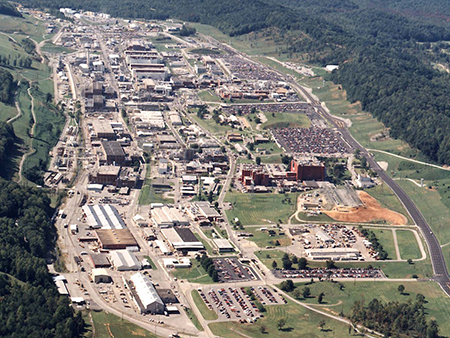“For 50 years, the Arms Control Association has educated citizens around the world to help create broad support for U.S.-led arms control and nonproliferation achievements.”
U.S. Energy Department to Reshuffle Warhead Budgets
July/August 2025
By Lipi Shetty
In documents outlining its $46.3 billion budget request for fiscal year 2026, the U.S. Department of Energy indicated that the W93 submarine-launched ballistic missile warhead would receive accelerated funding, while the W87-1 intercontinental ballistic missile (ICBM) warhead would receive less funding than previously anticipated.

Of the department’s total budget request, $30 billion is for the National Nuclear Security Administration (NNSA), a 24-percent increase from the fiscal 2025 enacted budget.
The overwhelming proportion of NNSA’s budget request—$25 billion, or 83 percent—would be allocated toward nuclear weapons activities. That includes $4.8 billion made available through a budget reconciliation bill approved by Congress July 3 and signed into law by President Donald Trump July 4. The total NNSA weapons activities budget would increase by 28.8 percent over the fiscal 2025 level of $19 billion.
The Energy Department request executes “seven simultaneous warhead modernization programs, including the B61-13 variant and the warhead for the nuclear-armed sea-launched cruise missile (SLCM-N Warhead), while coordinating with [the Defense Department] to plan for future systems.”
The budget significantly cuts the W87-1 warhead program from $1 billion enacted in the fiscal 2025 budget to $649 million requested for fiscal 2026, a 36 percent decrease, due to a “one-time use of carryover to fund FY 2026 activities.”
In fiscal 2026, the W87-1 program is expected to continue development engineering, including “joint testing with the Air Force Sentinel.” The Sentinel ICBM, on which the W87-1 will be fielded, has faced major delays and increasing costs. (See ACT, September 2024.)
Meanwhile, funding for the W93 submarine-launched ballistic missile warhead would increase by over $350 million to $807 million under the NNSA plan for fiscal 2026.
Last year, in the Biden administration’s fiscal 2025 budget request, NNSA had said it planned to spend $1.2 billion on the W87-1 in fiscal 2026, and only $465 million on the W93.
Highly enriched uranium for both warheads is produced at Building 9212 at the Y-12 National Security Complex in Oak Ridge, Tenn., which this year’s budget document recognizes as failing to “meet modern nuclear safety and security standards.” Despite this, the W87-1 program will rely on Building 9212 until the Y-12 Uranium Processing Facility, which is now under construction, is available as its replacement.
The facility has faced delays, with the fiscal year 2026 budget indicating it would not be operational until early 2032. Last year, the projected completion date was set at mid-2030. This year’s request states, “Significantly larger… [p]roject delays would require extended W93 production in Building 9212, worsening inefficiencies that drive risk to the program’s cost and schedule.” The W93 warhead is still in its early phases and has “not developed a complete design definition,” according to the request.
Costs for pit production and facility operations would total nearly $3.8 billion dollars in fiscal 2026 under the NNSA’s budget plan, with “reestablishing necessary pit production capabilities remain[ing] DOE/NNSA’s highest infrastructure priority in FY 2026.”
The W87-1 and W93 warheads are “setting the pace and quantity for pit production now,” and “NNSA’s long-term stewardship of the nuclear stockpile, including future weapons systems, will require newly produced pits,” according to James McConnell, NNSA’s acting principal deputy administrator, and Dave Hoagland, acting deputy administrator for defense programs, in a joint statement before the Senate Armed Services Strategic Forces Subcommittee May 20.
The documents also detail a $150 million request for the program tasked with evaluating the need for future warheads at the direction of the Nuclear Weapons Council, known as Studies and Assessments, a 117 percent increase from the $69 million enacted in fiscal 2025. These funds will support concept assessments of a variety of hard and deeply buried targets options, next generation reentry capabilities, and design options for a future strategic warhead. The NNSA expects to complete in fiscal 2026 the first phase of its concept assessment of next generation reentry capabilities, which last year’s request described as focused on nonballistic reentry options.
Funding for the B61-13 high-yield gravity bomb would increase from $16 million to $49 million. The first B61-13 production unit left the assembly line in late May, one year ahead of schedule. This follows completion of the final stages of the B61-12 life extension program, which produced its last unit in 2024.
An additional $272 million dollars was requested for a warhead for the nuclear capable sea-launched cruise missile, known as the SLCM-N, which the Biden administration previously opposed. (See ACT, July/August 2024.)
The budget documents also request $7 billion for defense environmental cleanup, which is about 15 percent of the total Energy Department request, and a 5-percent cut from the fiscal year 2025 enacted amount.
In early February, around 300, or 15 percent of NNSA federal employees, were fired as a part of a purge of federal workers by the Trump administration. (See ACT, March 2025.) Following backlash from members of Congress, all but 27 of those firings were rescinded. Over 130 employees took the government’s payout offer and resigned, The New York Times reported, bringing total loss of staff to around 8 percent.
When asked by Sen. Angus King (Ind.-Maine) if any cost-benefit analysis has been made to assess the impact of staffing cuts on the NNSA, McConnell told the Senate Armed Services Strategic Forces Subcommittee May 20, “I am not aware we have done an analysis in that parameter space. We have evaluated the risk to our mission of the recent reductions of staff and found them acceptable for now and in the short term to continue to achieve our mission.”
